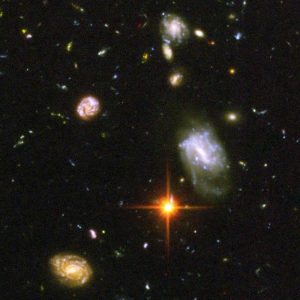
Can light travel without a carrier such as a gravitation field? Light does travel via a carrier, in the same way gravity does. If we think about light as a continuous phenomenon, this carrier is the electromagnetic field, just as gravity is “carried” by a gravitational field. If we think about light as a particle, then the carrier is the photon (just as the graviton is the mediator particle for the gravitational force in theories of quantum gravity).
In the nanoseconds after the Big Bang, did light stop at the edge of the bubble?
The most important part of the answer to this question is that there was no bubble and no edge. The expansion of space (either in the very early Universe or now) does not occur around a special point; rather, every point recedes from every other point in a uniform way. If the Universe is infinite in extent now (and we have no evidence to the contrary), then it was also infinite in the very earliest moments of time, but every point was closer to every other point that it is now. (That is one of the concepts in cosmology that is inarguably mathematically true but very difficult to wrap one’s head around.)
A related question one could ask, though, is: Can the Universe expand faster than the speed of light? The answer to that question is yes, but you have to be careful what you mean by “space expanding,” as my colleague Rachael Livermore explains in this Ask An Astronomer reply.
Dr. Tom Crawford
University of Chicago
